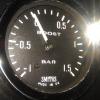
Coilover Suspension Experience
#1

Posted 22 April 2013 - 06:30 AM
#2

Posted 22 April 2013 - 09:36 AM
for coilovers you need to carry out quite a lot of strengthening to the rear turrets as you will be putting all the rear suspension load through them as opposed to the standard system of loading the subframe.
imo coilovers are only really for a track car.
im using them on my project but it will be a track car used rarely on the road.
regards
Ben
#3

Posted 22 April 2013 - 10:09 AM
#4

Posted 22 April 2013 - 10:44 AM
I cant comment regarding fitting as I didnt fit them but I have adjusted them which is easy enough. Use the special tool to wind the springs up and down and then adjust the shocks to match.
They are ok if youre not driving all the time. The major fault is that they are too hard for me. I find myself crashing along any road with a bump (so all of them!). The problem is to soften them up you have to lower the car (giving more travel to the springs) or change spring poundage. My car is already as low as I can go and I think they are on the softest springs!
If I break a coil or the car comes off the road for an overhaul it may be worth changing them back to cones to save my back but they are fine for the occasional use my Mini gets.
#5

Posted 22 April 2013 - 11:38 AM
Edited by joyce1bro, 22 April 2013 - 01:27 PM.
#6

Posted 22 April 2013 - 02:29 PM
#7

Posted 22 April 2013 - 05:31 PM
I bet that you have no idea of the actual peak loads involved, or the shear strength of a 1/4" bolt.
A Mini thus modified WILL suffer structural failure, the thing that you can't predict is exactly when, as it depends on how it is driven and how smooth the roads are.
#8

Posted 22 April 2013 - 05:42 PM
#9

Posted 22 April 2013 - 05:57 PM
Would these be any better ?
#10

Posted 10 May 2013 - 03:13 PM
#11

Posted 10 May 2013 - 08:48 PM
That is inevitable with coil springs, because even the variable rate type does not have the rapidly rising spring rate of the rubber cone, and there is no combination of rates that will work correctly, either they are ridiculously hard and give a terrible ride and poor roadholding, or they cause the problem you are having.
By the way, the bump stops are vital, and without them you will break a ball joint eventually, possibly causing a serious accident and certainly damaging the car. Your insurance will be void if you drive the car in a state like that, so I strongly suggest that you revert the suspension to the configuration which Issigonis originally designed, with rubber cones, which is all that will work properly with such short wishbones and limited travel. Unless, of course, you manage to fit a Citroen style hydropneumatic system, which uses automatic control of ride height to keep the suspension workingh in its useful range despite changes in load.
#12

Posted 11 May 2013 - 08:32 AM
That is inevitable with coil springs, because even the variable rate type does not have the rapidly rising spring rate of the rubber cone, and there is no combination of rates that will work correctly, either they are ridiculously hard and give a terrible ride and poor roadholding, or they cause the problem you are having.
By the way, the bump stops are vital, and without them you will break a ball joint eventually, possibly causing a serious accident and certainly damaging the car. Your insurance will be void if you drive the car in a state like that, so I strongly suggest that you revert the suspension to the configuration which Issigonis originally designed, with rubber cones, which is all that will work properly with such short wishbones and limited travel. Unless, of course, you manage to fit a Citroen style hydropneumatic system, which uses automatic control of ride height to keep the suspension workingh in its useful range despite changes in load.
Out of interest, if the bump stop was removed from a orginal coned set up would it knock?
#13

Posted 11 May 2013 - 09:12 AM
If you remove the bump stop from a standard rubber cone setup, you can undeed break the ball joints, but only under extreme conditions, as the rising rate of the rubber spring discourages an extreme amount of suspension deflection. However, if you are using rubber, and have lowered it ising a HiLo, or a shortened trumpet, then the risk of broken ball joints returns. Actually, the risk is still there, even with bump stops, because on a seriously lowered car they are liable to get such a hammering that they rapidly fail.
Take a look at the little bit of rubber that is the bump stop, in comparison to the spring or cone, and estimate how much of a hammering it will survive.
#14

Posted 11 May 2013 - 03:39 PM
Coilovers have a integral bumpstop, or at least they should have..........
There probably is one, but i don't think it is even touching that. The bottom bracket for the bottom of the coilover ( that sits over the ball joint) knocks the part of the sub frame where the bump stop used to bolt to. And this is at a height where the car is riding HIGHER than before when i was using hi/lows?!
1 user(s) are reading this topic
0 members, 1 guests, 0 anonymous users


















